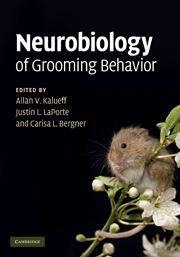Book contents
- Frontmatter
- Contents
- List of contributors
- Preface
- 1 Grooming, sequencing, and beyond: how it all began
- 2 Self-grooming as a form of olfactory communication in meadow voles and prairie voles (Microtus spp.)
- 3 Phenotyping and genetics of rodent grooming and barbering: utility for experimental neuroscience research
- 4 Social play, social grooming, and the regulation of social relationships
- 5 Grooming syntax as a sensitive measure of the effects of subchronic PCP treatment in rats
- 6 Modulatory effects of estrogens on grooming and related behaviors
- 7 Lack of barbering behavior in the phospholipase Cβ1 mutant mouse: a model animal for schizophrenia
- 8 Grooming after cerebellar, basal ganglia, and neocortical lesions
- 9 Striatal implementation of action sequences and more: grooming chains, inhibitory gating, and the relative reward effect
- 10 An ethological analysis of barbering behavior
- 11 Should there be a category: “grooming disorders?”
- 12 Neurobiology of trichotillomania
- Index
- References
12 - Neurobiology of trichotillomania
Published online by Cambridge University Press: 04 August 2010
- Frontmatter
- Contents
- List of contributors
- Preface
- 1 Grooming, sequencing, and beyond: how it all began
- 2 Self-grooming as a form of olfactory communication in meadow voles and prairie voles (Microtus spp.)
- 3 Phenotyping and genetics of rodent grooming and barbering: utility for experimental neuroscience research
- 4 Social play, social grooming, and the regulation of social relationships
- 5 Grooming syntax as a sensitive measure of the effects of subchronic PCP treatment in rats
- 6 Modulatory effects of estrogens on grooming and related behaviors
- 7 Lack of barbering behavior in the phospholipase Cβ1 mutant mouse: a model animal for schizophrenia
- 8 Grooming after cerebellar, basal ganglia, and neocortical lesions
- 9 Striatal implementation of action sequences and more: grooming chains, inhibitory gating, and the relative reward effect
- 10 An ethological analysis of barbering behavior
- 11 Should there be a category: “grooming disorders?”
- 12 Neurobiology of trichotillomania
- Index
- References
Summary
Summary
Trichotillomania (TTM) is a common debilitating impulse control disorder, which is under-recognized in clinical practice. New research shows interesting similarities between TTM, other impulse control disorders, and obsessive–compulsive disorder (OCD), while also revealing important differences in some endophenotypic measures. In this chapter we review new advances in genetic, family, neurocognitive, neuroimaging, and neuropharmacological studies. Neural abnormalities in the amygdalo–hippocampal formation and frontal–subcortical circuits are discussed. Animal models of hair pulling are also outlined and may prove a fruitful avenue for future research.
Introduction
Trichotillomania is a neuropsychiatric disorder characterized by noticeable hair loss due to a recurrent failure to resist impulses to pull out hairs. The hair pulling is usually preceded by mounting tension and followed by a sense of relief or gratification (WHO 2002). It predominantly affects females (Swedo and Leonard 1992), and its onset is usually in late childhood and adolescence (Walsh and McDougle 2001). A subgroup with very early onset of hair pulling in children under the age of six may be more benign and self-limiting (Keren et al. 2006). Often accompanied by shame and distress, TTM is under-recognized in clinical practice and its prevalence is likely to be greater than currently understood (Bohne et al. 2005b). There have been no population-based epidemiological studies of TTM. In a sample of 2579 college students in the United States, a lifetime prevalence of TTM was seen in 0.6%, though subthreshold symptoms not reaching diagnostic criteria were identified in 1.5% of males and 3.4% of females (Christenson et al. 1991b).
- Type
- Chapter
- Information
- Neurobiology of Grooming Behavior , pp. 252 - 270Publisher: Cambridge University PressPrint publication year: 2010



